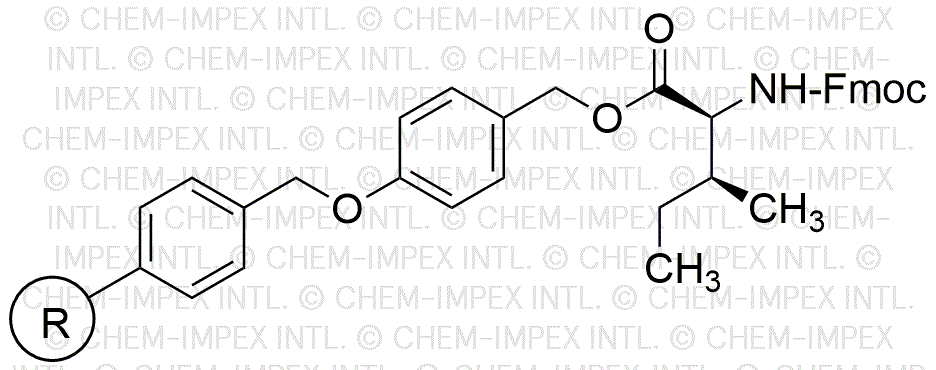Fmoc-L-isoleucine 4-alkoxybenzyl alcohol is widely utilized in research focused on:
- Peptide Synthesis: This compound serves as a key building block in the synthesis of peptides, particularly in solid-phase peptide synthesis, allowing for the creation of complex and functional peptides used in drug development.
- Drug Development: Its unique structure enhances the solubility and stability of pharmaceutical compounds, making it valuable in the formulation of new medications, especially in the field of cancer research.
- Bioconjugation: The compound is employed in bioconjugation techniques, facilitating the attachment of biomolecules to surfaces or other molecules, which is crucial for creating targeted drug delivery systems.
- Research in Proteomics: It plays a significant role in proteomics studies, aiding in the identification and characterization of proteins, which is essential for understanding disease mechanisms.
- Material Science: The chemical is also used in the development of advanced materials, such as hydrogels, which have applications in tissue engineering and regenerative medicine.
General Information
Properties
Safety and Regulations
Applications
Fmoc-L-isoleucine 4-alkoxybenzyl alcohol is widely utilized in research focused on:
- Peptide Synthesis: This compound serves as a key building block in the synthesis of peptides, particularly in solid-phase peptide synthesis, allowing for the creation of complex and functional peptides used in drug development.
- Drug Development: Its unique structure enhances the solubility and stability of pharmaceutical compounds, making it valuable in the formulation of new medications, especially in the field of cancer research.
- Bioconjugation: The compound is employed in bioconjugation techniques, facilitating the attachment of biomolecules to surfaces or other molecules, which is crucial for creating targeted drug delivery systems.
- Research in Proteomics: It plays a significant role in proteomics studies, aiding in the identification and characterization of proteins, which is essential for understanding disease mechanisms.
- Material Science: The chemical is also used in the development of advanced materials, such as hydrogels, which have applications in tissue engineering and regenerative medicine.
Documents
Safety Data Sheets (SDS)
The SDS provides comprehensive safety information on handling, storage, and disposal of the product.
Product Specification (PS)
The PS provides a comprehensive breakdown of the product’s properties, including chemical composition, physical state, purity, and storage requirements. It also details acceptable quality ranges and the product's intended applications.
Certificates of Analysis (COA)
Search for Certificates of Analysis (COA) by entering the products Lot Number. Lot and Batch Numbers can be found on a product’s label following the words ‘Lot’ or ‘Batch’.
*Catalog Number
*Lot Number
Certificates Of Origin (COO)
This COO confirms the country where the product was manufactured, and also details the materials and components used in it and whether it is derived from natural, synthetic, or other specific sources. This certificate may be required for customs, trade, and regulatory compliance.
*Catalog Number
*Lot Number
Safety Data Sheets (SDS)
The SDS provides comprehensive safety information on handling, storage, and disposal of the product.
DownloadProduct Specification (PS)
The PS provides a comprehensive breakdown of the product’s properties, including chemical composition, physical state, purity, and storage requirements. It also details acceptable quality ranges and the product's intended applications.
DownloadCertificates of Analysis (COA)
Search for Certificates of Analysis (COA) by entering the products Lot Number. Lot and Batch Numbers can be found on a product’s label following the words ‘Lot’ or ‘Batch’.
*Catalog Number
*Lot Number
Certificates Of Origin (COO)
This COO confirms the country where the product was manufactured, and also details the materials and components used in it and whether it is derived from natural, synthetic, or other specific sources. This certificate may be required for customs, trade, and regulatory compliance.

